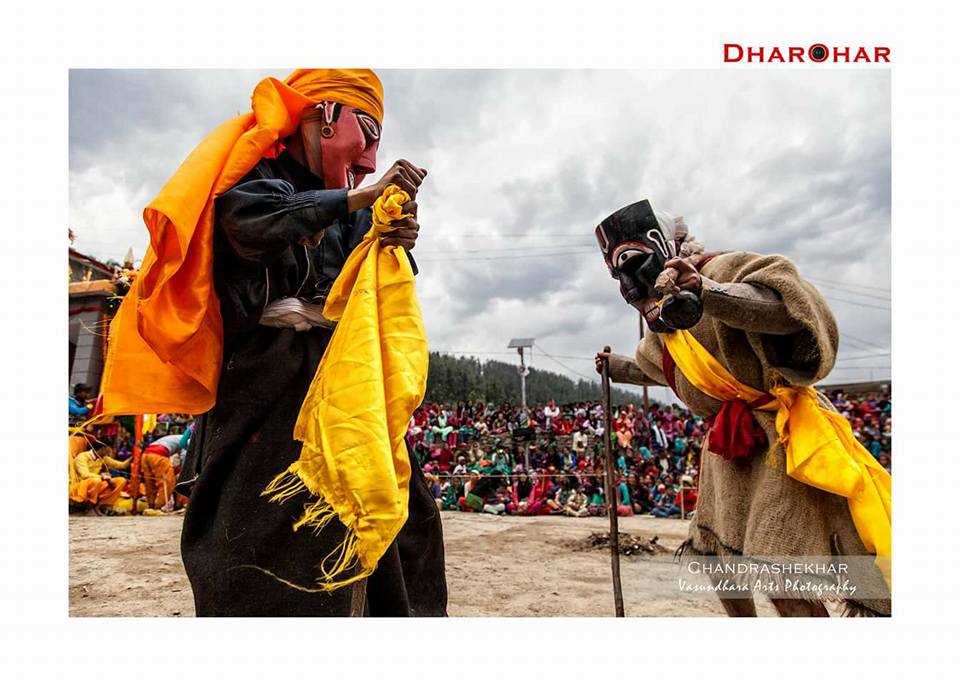Ramman is a renowned and famous folk festival held in salur dungra village in the vicinity of joshimath town enroute Badrinath puri. Ramman was declared a world cultural heritage by UNESCO in 2009. Ramman is an annual festival of Salur village celebrated in the month of april. The villages Dungri, Bharosi and Selong too celebrate this festival but the one celebrated in Salur is most famous and therefore was declared a cultural heritage by UNESCO. The village panchayat of Salur Dungra is the organizer of this renowned festival. Ramman festival is a fortnight long series of cultural events, prayers and religious rituals. Community prayers and rituals are held, religious acts done, folk dances performed, folk songs sung and many other religious activities held in village. Besides rituals and prayers, many other activities are carried to entertain the public. Ramman is the occasion to worship Bhumyal Devta (village deity considered as the owner of lands). It also means family reunions and arrival of relatives and guests.
On the last day of ramman certain selected scenes from Ramayana are enacted. Its because of these scenes from Ramayana which are enacted that the whole festival is known as Ramman. Many legendary, historical and mythological characters and events are enacted in dance form on this day. Huge crowd from nearby towns and villages gather to witness the performances enacted on the last day of Ramman. The word Ramman is derived from Ramayana the great epic. The amalgamation of the acts of Ramayana with the ancient mask dance form of holy Himalayas was termed Ramman. Later on the whole fortnight long festival was termed as Ramman.
The fortnight long Ramman festival begins on baisakhi, the first day of the month of baisakh (month in Hindu calendar).On this day the bhumyal devta (village deity) is worshipped. The idol of bhumyal devta is placed on top of a eleven feet long staff. The long staff is covered and decorated with colorful silk. The performer dances carrying this decorated staff held high, resting on his shoulder. On the third day of baisakh, the idol of Bhumyal devta begins its week long entourage of the village households.
From the third day of Baisakh, mask dance is performed every night at the Bhumyal devta temple premises. These wooden masks are related to different legendry, historical and imaginery characters. These masks are classified in two categories locally termed as “dayo pattar” and “khyalari pattar”. Dayo pattar are characters and masks related to gods, while khyalari pattar are characters and masks meant for the sole purpose of entertainment. Certain traditional entertainment performances are performed and some religious ceremonies done. Mask dance of the sun god is performed first. On this very night the Kalinka and ganesha mask performances are also enacted. On the fourth night of baisakh the Rani Radhika dance is performed related to lord Krishna and Radhika. On the following nights different historical and imaginary characters and scenes are performed like ‘the king of kangra’, ‘burdeva’, ‘merchant, his wife and thief’ etc. On a certain night the “gopichand” dance is performed. All these characters and mask performances have fixed sequences.
The last night or the night before Ramman is known as ‘syurtu’ which means whole night performance. All the masks and characters perform on this night. The ‘pandava nitya’ is also performed on this night. The drums play the Ramman beats and the ramyanis (the performers of ramman) dance on these beats. Children below eighteen years dance this night and from amongst these children the characters lord Rama, Lakshman, Sita and Hanuman are selected for the next day ramman. On this very night the performers of mallas (warriors) are also selected by drum beaters with the help of village elders. On the last day the ramman is performed. The venue of this event is the courtyard of bhumyal devta temple. On this day certain selected scenes from Ramayana are performed in the form of mask dance. The scenes enacted are;- Ram Lakshman birth, Ram Lakshman visit to janakpuri, Sita swayamvar (marriage), Ram vanwas, golden deer hunt, Sita haran (abduction), Hanuman Milan, Lanka dahan (burnt) and Rajtilak (coronation). All these scenes are enacted in dance form. All the dance performances are done on dhol (drum) beats. The performances begin with the dance of Ram and lakshman at temple courtyard. This dance is performed on five different drumbeats.
The performers of Ramayan rest after each performance while the historical and mythical characters ( mor-moryan, merchant- wife and thief, tiger, maal (warriors), kurjwogi ( a character covered in sticky thorny flower ). In intervals the Staff with idol of bhuyal devta also dances. Among the historical characters merchant – wife and maal (warriors) are the centre of attraction. The merchant and wife were wool merchants from Tibet who used to trade within Indian villages. A thief stole their merchandise and money. This story is performed in the form of dance. The maal (warrior) mask dance is the enactment of battles between the local warriors and the gorkha warriors during 1804-14. In this performance there are four warriors (two locals and two gorkha) holding swords and loaded guns. The performance ends with gun shots in air signifying victory over gorkhas. After the “maal” comes Kurujwogi wearing old and torn clothes. This performer is covered with ‘kuru’ a thorny and sticky flower which he throws on spectators. Then comes the Narsinga pattar and the story of lord Narsinga is enacted in dance form. The Ramaan festival concludes with the dance performance of bhyumyal devta. The whole ramaan is performed without using any dialogues.
